What Does the Communal Construction of Romanesque Art Suggest About Medieval Society

The heavily restored Romanesque castle of Wartburg gives an impression of the way it might take appeared in the 12th and 13th centuries

Romanesque architecture is an architectural style of medieval Europe characterised by semi-circular arches. The term "Romanesque" is usually used for the menses from the tenth to the 12th century with "Pre-Romanesque" and "First Romanesque" being applied to before buildings with Romanesque characteristics. Romanesque compages tin can be found across the continent, diversified by regional materials and characteristics, merely with an overall consistency that makes it the first pan-European architectural style since Imperial Roman Architecture. The Romanesque manner in England is traditionally referred to every bit Norman architecture.
The commonest surviving Romanesque buildings are churches, of which many are notwithstanding continuing, more or less intact and frequently in use.[1] Many of these churches were built as abbeys, to serve religious communities. The living quarters and other monastic buildings of these abbeys establish a significant part of the remaining domestic architecture of the Romanesque period.
The second most mutual blazon of surviving Romanesque edifice is the castle, of which the slap-up majority are in ruins, as a effect of war, or the practice of dismantling castles that might after be used in uprisings. A number of ruined or much contradistinct imperial palaces, some of them within castle walls, others unfortified, accept likewise survived in Frg and Alsace.
Examples of purely domestic architecture include the great hall of a fortified manor in England, and a small number of big boondocks houses in France and Federal republic of germany and several palazzos in Venice. A great many more pocket-size houses are spread across Europe, oft profoundly altered by the insertion of later windows, and sometimes with their antiquity unrecognised and unrecorded.
History [edit]
The following is a summary of essential points from the department History in the article cited to a higher place.
Origins [edit]
Romanesque compages was the first distinctive style to spread across Europe since the Roman Empire.[2] Architecture of a Romanesque fashion developed simultaneously in the northward of Italy, parts of France and in the Iberian Peninsula in the tenth century.
Politics and religion [edit]
The Romanesque menstruum was a time of frequent conflict. Much of Europe was afflicted by feudalism in which peasants held tenure from local rulers over the state that they farmed in substitution for military service and employment on building projects. This resulted in the building of castles at strategic points, many of them being synthetic every bit strongholds of the Normans, descendants of the Vikings who invaded northern French republic in 911. The invasion of England by William, Duke of Normandy, in 1066, saw the building of both castles and abbeys which reinforced the Norman presence. Political struggles also resulted in the fortification of many towns, or the rebuilding and strengthening of walls that remained from the Roman flow. One of the virtually notable surviving fortifications is that of the urban center of Carcassonne. The enclosure of towns brought nigh a lack of living space within the walls, and resulted in a style of boondocks house that was tall and narrow, often surrounding communal courtyards, as at San Gimignano in Tuscany.[3] [4]
In Federal republic of germany, the Holy Roman Emperors built a number of residences both castles and palaces, at strategic points and on trade routes. The Imperial Palace of Goslar (heavily restored in the 19th century) was congenital in the early 11th century by Otto Iii and Henry III, while the ruined Palace at Gelnhausen was received by Frederick Barbarossa prior to 1170.[five] The movement of people and armies too brought almost the building of bridges, some of which have survived, including the 12th-century bridge at Besalú, Catalonia, the 11th-century Puente de la Reina, Navarre and the Pont-Saint-Bénézet, Avignon.[6]
The system of monasticism in which the religious become members of an order, with mutual ties and a common rule, living in a mutually dependent community, rather than every bit a group of hermits living in proximity but essentially split, was established by the monk Bridegroom in the 6th century. From this time onwards, monasteries were established across Europe, bringing about non only the construction of large churches, but as well cloisters, domestic quarters and other buildings associated with community living such as hospitals, barns, and forges.[vii] [8]
The Crusades, 1095–1270, which were intended to wrest the Holy Places of Palestine from Islamic control, resulted in the building of castles in Syria and Palestine. The Crusades brought about a very large movement of people and, with them, ideas and trade skills, particularly those involved in the building of fortifications and the metallic working needed for the provision of arms, which was also applied to the plumbing fixtures and decoration of buildings. The continual movement of people, rulers, nobles, bishops, abbots, craftsmen and peasants, was an important factor in creating a homogeneity in building methods and a recognizable Romanesque style, despite regional differences.[9]
- Politics
-
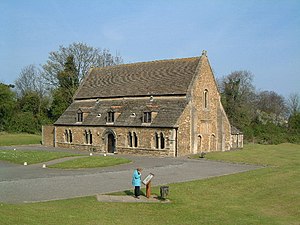
The Great Hall of Oakham Castle, England, once office of the fortified manor of a Norman baron.
-
Many towns, such equally San Gimignano, were enclosed with walls, causing crowding and the building of tower houses.
Characteristics [edit]
Walls and Materials [edit]
Virtually domestic buildings of the Romanesque period were built of wood, or partly of wood. In Scandinavian countries, buildings were frequently entirely of woods, while in other parts of Europe, buildings were "half-timbered", constructed with timber frames, the spaces filled with rubble, wattle and daub, or other materials which were then plastered over.[ten] Rock was often used for basements. The building cloth differs greatly across Europe, depending upon the local stone and building traditions.[11]
While in most countries stone is the usual material for substantial buildings such as castles and palaces, in much of Poland, Federal republic of germany, northern Italian republic and holland, brick is more commonly used. Where stone has been used for domestic buildings, it is often in comparatively pocket-sized and irregular pieces, bedded in thick mortar. Smooth ashlar masonry was used where hands worked limestone was available.[12] For defensive buildings such equally castles, the walls are massively thick. In all Romanesque architecture, the windows tend to be small. The general impression of Romanesque compages is of solidity and force.[1]
-
Irregularly shaped hewn blocks and thick mortar at a town house, in Mont-de-Marsan. This house has a jettied upper floor supported on stone corbels.
-

Limestone ashlar masonry in even courses at Scarborough Castle. The buttresses of low profile are characteristic of Romanesque building.
-

This house at Poreč, Croatia, has a reconstructed cantilevered wooden walkway, paired windows and the cord course that were common features.
-
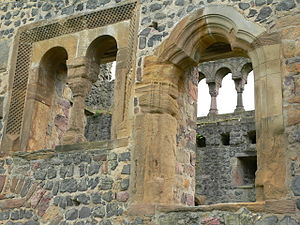
Münzenberg Palace has walls of rubble simply refined detailing in its windows, the triple arch of the door and the gallery seen across which opens onto a vista.
Arches, arcades, piers and columns [edit]
Arches in domestic compages across Europe during this menses are e'er semi-circular, with the merely exceptions occurring in palatial buildings in Sicily where Norman architecture was influenced by the Islamic style. Arcades (rows of arches) occur in the interior of large buildings such as the great hall of a castle, supporting the timbers of a roof or upper flooring. Arcades are also used to create cloisters and loggias. Arcading on a large calibration generally fulfils a structural purpose, but information technology is as well used on a smaller scale, every bit a decorative characteristic, both internally and externally.
In Romanesque domestic architecture, arcades were nearly often supported on piers. They were built of masonry and are of square or rectangular section, generally having a horizontal moulding representing a capital at the springing of the arch.[1] [2] Columns were also used to support arcades and vaults, but are a feature of palace, civic and monastic compages, rather than smaller houses. Colonnettes and fastened shafts are also used structurally and for decoration.[1] The capital letter on top of a column is normally cut then that it is round at the bottom, where it sits on the cavalcade, and square at the top where it back up the curvation. A capital might be undecorated, or else have foliate or figurative carving.
-
The interior of Rochester Castle, showing galleries in the interior walls and an arcade dividing the neat hall.
-
The Broletto at Como has serial of arcades, the outer with polychrome voussoirs, supporting a timber roof on brackets.
-
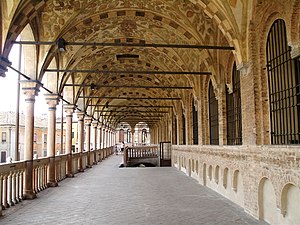
Vaults and roofs [edit]
Timber was used extensively in building. The majority of buildings have open wooden roofs.[ten] When building have rock undercrofts, or basements, this lower floor may be vaulted, with a butt or groin vault. Vaulted domestic spaces are particularly found in monastic buildings, castles and palaces where skilled master masons were employed. Towards the finish of the period, vaulted spaces in monastic buildings employed the ribbed vault, as information technology was used in abbey churches.
Doors and windows [edit]
Narrow doors and pocket-sized windows are frequently square topped, existence bridged by a solid stone lintel which may be supported on projecting brackets. Some stone buildings have retained wooden lintels. Larger doorways and windows are topped with semi-round arches, equally are arcades and vaults. Large doorways in more elaborate dwellings are often set within three archivolts or mouldings and may also accept corbels or colonnettes and capitals, equally at the Jew's house at Lincoln. Square-topped windows are often set in groups, with two or 3 beneath a unmarried lintel. Round-topped windows are oftentimes paired nether a wide arch, and separated by stone mullions or colonnettes. In Sicily there are a number of palaces and churches where the pointed arch is used during this period, patently adopted from Islamic compages.
- Vaults, doors, windows, stairs and chimney
-
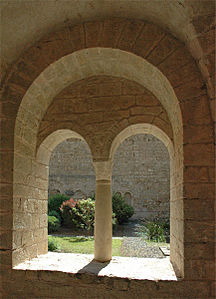
-
The chimney of Hôtel des Monnaies, Cluny, France
Architectural embellishment and sculpture [edit]
Stone buildings are frequently ornamented with projecting courses which may exist flat fillets or rounded mouldings. These are sometimes carved with patterns, particularly chevrons. An arched doorway that is set into a thick wall may exist deeply recessed, and have iii or more bands of moulding around it. Doorways sometimes take colonnettes with small capitals, every bit are also found on the transoms that carve up paired windows. Sometimes capitals and corbels are carved with floral motifs or figures.
Arcading is a significant decorative feature of Romanesque architecture, occurring most often in domestic compages every bit a Lombard ring which is a row of minor arches that announced to back up a roofline.
-

The delicately carved lintel of the same house. The movie also reveals the derelict state of this rare building (2006).
Colour [edit]
Colour was used in a diverseness of ways to enhance buildings during this period. Rendered walls could exist coloured, with different fashions prevailing in different regions. Stone buildings sometimes had external details picked out in colour. In Italy buildings were often constructed with alternating bands of brick and rock. In Venice, the palaces of wealthy families had veneers of marble which contrasted with the painted stucco. Internally, the big wall surfaces and obviously, curving vaults of the Romanesque catamenia lent themselves to mural decoration and traces of them accept been found in castles and wealthy homes.[13] Withal, the vast majority of these paintings, like the buildings themselves have been destroyed by rebuilding and redecoration, damp, state of war, neglect and irresolute fashion. The few exceptions of secular decoration have generally survived considering they were in the care of the church. Very rare survivals of loftier quality are the paintings from Arlanza in Espana, which are now dispersed to museums in Barcelona and America. These frescos of nigh 1210 come from a monastery, but have secular bailiwick thing, and presumably are like to those that existed in some palaces. There are a number of huge real and mythical animals reflecting the world of heraldry and illuminated bestiaries.[fourteen]
Tapestries and other cloth hangings were also used to decorate palaces, with the Bayeux Tapestry much the best known example – though now in Bayeux Cathedral it was very probably originally fabricated to decorate Bishop Odo's palace hall in the 1070s, and other such hangings are recorded. The narrative tale of a heroic victory in war was another theme no doubt frequently repeated. The 11th-century Fabric of St Gereon may always accept been in a church, only its adoption of designs from figured Eastern textiles was likewise probably a style used in grand homes. Textile hangings helped to keep draughty stone buildings warm, and had the corking advantage for those with many homes of existence relatively piece of cake to comport between them.[15]
Monastic buildings [edit]
Within the Catholic tradition, communal monasticism was established past Saint Benedict at Monte Cassino around 529. It was encouraged by Charlemagne with an increasing number of monasteries being founded across Europe in the late Middle Ages. The well-nigh influential orders during that menstruum were the Benedictines, the Cluniacs founded at Cluny in 910, and so the Cistercians founded in 1098. Bernard of Clairvaux entered the Cistercian Society in 1113 and, as its leader, founded more than five hundred monasteries of austere design and often in remote locations.[16]
The Carolingian Plan of Saint Gall dating from the early ninth century is a detailed draught of an abbey church building and its accompanying monastic buildings, the oldest such architectural plan to be since Roman times. It shows an idealised arrangement with individual cells for monks, workshops, civilities, gardens, stables and a schoolhouse. Information technology constitutes a living space for a completely cocky-sufficient community.[17] Natural constraints such as the building site, the shut proximity of town buildings, and lack of funds meant that in practice few monasteries were so lavishly synthetic during the Romanesque menstruum. From the tenth century, the great Abbey of Cluny prepare a standard of edifice and amenities that was to be emulated by others.
The surviving domestic and utility buildings of monastic complexes are in general set apart from the surviving dwellings of the mutual laity by the quality of both structure and particular. Although congenital for the communal living of lives vowed to poverty and simplicity, monastic buildings are in full general solidly constructed and finely finished with vaulted ceilings, mouldings, columns and carvings that are direct related to the forms found in monastic churches, while the cloisters that formed the nucleus of monastic life are ofttimes masterpieces of Romanesque structure, style and ornament.
-

Cloister and well-house of the monastery Unser Lieben Frauen, Magdeburg, Germany.
Types of buildings [edit]
In general, the master living and working quarters of any monastery were the cloisters, iv arcaded passages that surrounded a courtyard and were located, wherever possible, adjacent to and on the southern (sunniest) side of the church.[eighteen] The arcades at ground level were the monk's working and general living space, containing carrels for study and writing, and often along i range, a "lavatorium" where the monks could wash their hands and faces before eating. To a higher place the arcades ran long dormitories where the monks slept. Where such buildings still exist from the Romanesque menstruum, they are built of stone, although at the majority of early monasteries, they were probably of wooden construction. Monastic buildings more often than not became increasingly comfortable and more robust over fourth dimension, with stone replacing wood, open arcades being glazed confronting the air current and open dormitories being fitted with wooden screens for warmth and privacy.[eighteen]
A number of buildings surrounded and abutted the curtilage. The chapter business firm was the most significant, as the meeting place of the governing body of the abbey. It mostly projected from the eastern side of the cloister, and might have near information technology a narrow passage or "slype" that led to a burial ground near the eastern terminate of the church building.[18]
As well off the cloister arcade was a calefactory or "warming room" where a burn down burnt during the winter. It was more often than not located under part of the dormitory. A staircase often descended from the dormitory straight into a transept of the church, and was used by the monks at nighttime. Projecting from the dormitory was the "necessarium" or toilet block, with a drain running beneath the toilets.[18] An important edifice of which a number of examples have survived was the refectory or dining hall. Adjacent to the refectory were the monastic kitchens, with their proximity to the cloister being adamant by whether the cooking was washed by the brethren of the monastery or by lay employees.[xix]
Set autonomously from the cloister was the infirmary for the treatment of the sick, and where elderly frail members of the monastic community could be cared for. This was by and large a large hall but might constitute a whole separate complex with its own chapel, kitchen and courtyard. A split up dining bedroom known as the "misericord" was often attached to the hospital, so that sick and infirm anile brothers could benefit past eating red meat, something not permitted in the refectory.[19]
Early in the institution of monasteries, it was expected that the abbot or prior would live in the dormitory, in communion with the other monks. As the role of abbot became increasingly that of a concern managing director and entrepreneur, this humble living manner was abased, and separate houses were congenital, exterior the cloister.[nineteen] Other buildings ordinarily occurring within monastic precinct include bakehouses, breweries, granaries, well houses, forges, barns and dovecotes.[twenty] Guest houses were often built for travellers, and alms houses for the care of the poor. Schools were besides constitute in association with monasteries. Many monasteries had a gatehouse where a member of the laity lived and guarded the monastic precinct.[20]
Examples [edit]
Monastic complexes ofttimes developed over several centuries, with buildings of different dates abutting each other, and individual buildings beingness enlarged and altered in later architectural periods. Apart from churches (which are dealt with in a separate article), big Romanesque buildings are rare, even within the context of ancient monasteries. Even so, a number of fine examples be, scattered beyond Europe, with Sénanque Abbey, consecrated in 1178, beingness a rare survival that has retained many of its original Romanesque buildings intact, including the church building, cloister, dormitory, calefactory and chapter house. The monastery of St Martin-du-Canigou, founded 1005, has also retained its original class and some of its original domestic buildings, although damaged, both past earthquake and over-zealous restoration.[21] At Maulbronn in Deutschland the medieval monastery has remained virtually intact, merely typically the buildings vary in appointment, with the earliest being Romanesque of the late 12th century.[16] The Abbey of Fontenay has retained a number of important buildings including the monks' dormitory, the monks' hall, the scriptorium and a big forge.
At Lorsch in Deutschland and at Coffin St Edmunds in England remain 2 impressive gatehouses of very different styles. The Lorsch Abbey gatehouse led into a circuitous the course of which tin at present simply exist adamant by archaeology. The gatehouse itself dates from 774 and combines a number of features from Classical Artifact such as Corinthian columns and the triumphal arch motif with Northern European vernacular in the triangulation of the "arches" of the upper story and the steeply pitched roof, and Byzantine decoration in the polychrome surface decoration.[17] The Norman Tower at Bury St Edmunds was built past Abbott Anselm in the second quarter of the 11th century as the chief archway to the monastery from the town.[22] It rises in four stages of different heights, with a single biconvex portal and groups of three openings of varied blueprint on the upper levels, between flattened corner buttresses.
Romanesque cloisters remain at many ancient monasteries, particularly in French republic, Spain and Italy. They vary from simple structures with wooden trussed roofs or groin vaults and arcades supported on stout piers as at St Milchael'southward, Hildesheim, to elegant ribbed-vaults and arcades filled with plate tracery like those at the Cathedral of Tarragona, Spain, and supported on highly decorated paired columns with figurative capitals like those at St Pierre, Moissac, French republic and St John Laterano, Rome. The cloisters sometimes retain an upper arcade which gave admission to dormitories or cells, every bit at the Cathedral St. Léonce and the monastery of Santo Domingo de Silos in Burgos.
Of the various chambers that abutted the cloisters, those on the basis flooring frequently had groin or ribbed vaults like those found in the scriptorium at Fontenay. Where large buildings such equally the forge at Fontenay take survived, they take the grade of barn-like halls with flattened buttresses and modest round-headed windows.
Cloisters often contained a well. At Unser Lieben Frauen in Magdeburg, Germany, there is an elaborate well-house in the curtilage, while a ruined example exists at Mellifont Abbey.
- Monastic cloisters
-
The cloisters at Millstatt Abbey, Austria take alternating piers and openings.
-

The cloisters at the St Pierre Abbey, Moissac, French republic are renowned for their carved capitals.
Fortified buildings [edit]
The castle represents, overwhelmingly, the type of domestic architecture for which there is the greatest number of surviving examples in the Romanesque style. In that location also exist a range of domestic buildings associated with monastic precincts, palaces, borough buildings and town houses.
Keeps [edit]
Castles developed from wooden palisades, built for defense, or from mottes where an world mound, ordinarily bogus, was surmounted by a tall wooden structure and often surrounded past ditches. This latter system of defense was farther developed with the addition of outer palisades enclosing a bailey in which domestic buildings were constructed.[23] From well-nigh chiliad onwards the wooden building on the motte was replaced with a donjon (stone continue), the earliest of which is believed to have been at Doue-la-Fontaine, Maine-et-Loire, France, congenital in most 950.[24]
Judging from the size of the openings to exist establish in the lower stories, the earliest tall stone buildings appear to take served chiefly every bit residences. Nevertheless, with necessity, they developed an increasing number of defensive features. Many such castles were to be erected by the Norman invaders of England. Although a number of twelfth-century keeps such as those of Houdan and Provins castles in France were circular or polygonal in plan, square keeps predominated in England. Examples of square keeps include the White Tower (the Tower of London), Castle Hedingham in Essex and Rochester Castle in Kent.[25] After 1150, there were a greater number of polygonal keeps, which were harder to mine. Examples include those at Windsor Castle, Conisborough and Orford castles.[26]
These castles of rectangular programme are hall-keeps, with their primary purpose existence as the dwelling house of a ruler, the hall beingness the main living bedchamber, more often than not on the offset floor.[26] In some such keeps the basement level has columns supporting a vault. The floors above this are of woods, supported on long timber beams of which plenty could exist cutting from the forests at that engagement. Within a large keep like that at Rochester, the main spaces could be divided by a stone wall or tier of arcades rising through several storeys. Many castles had projecting turrets at the corners which contained screw staircases, while the thick walls of the upper storeys contained passages. Rochester has retained a fireplace prepare into a wall within a decorated curvation. Upper floors of Romanesque keeps sometimes accept differentiated windows marking the private rooms of the lord and lady. There may also be a chapel; for example, located in the White Tower of the Belfry of London is the St John'due south Chapel, set in a corner turret.
In mountainous regions, castles oft take highly irregular forms, adapting the programme to the site in varied ways. Castles have often developed over the centuries and typically have had additional encircling walls added. Between 1072 and 1080, Sancho III of Navarre (the Great) congenital Loarre Castle on a loftier rocky ridge in the foothills of the Pyrenees, as a delivery to the Reconquista. The castle was further fortified in the 13th century past an outer wall with 10 towers. Although outwardly of ascetic advent, Castle Loarre has living quarters of comparative comfort, and a chapel ornamented with fine carvings.[27]
- Development of the castle keep
-

A reconstructed motte and tower at Lütjenburg, Germany.
-
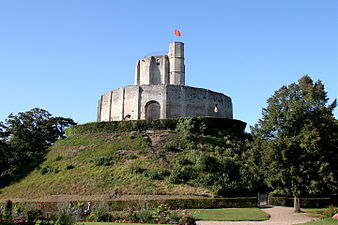
The polygonal donjon at Gisors, France, on a motte with an encircling wall.
Walled castles and palaces [edit]
Other castles begun in the 11th century were built on elevated sites that took advantage of the steep slopes for defense, rather than on moats. The fundamental belfry became the final defensive layer of the castle,[28] while the main domestic quarters were built against the walls around the perimeter, allowing plenty of room for a variety of functions. Conisborough Castle is an English example, with the vanquish go on rising on the earlier motte, and a wall with the residential and service quarters built into information technology, enclosing the bailey. The ruins within the bailey show remains of a great hall with central fireplace, a kitchen and a ii storeyed residential cake with adjacent latrines. The proceed itself contains a room for the lord, complete with a hooded fireplace, while a small vaulted chapel was built into the thick outer wall of the go along.[5] Ludlow Castle, Shropshire begun in the 11th century, was lived in by a number of members of the Tudor royal family and had both its fortifications and living quarters improved over several centuries.
The Hohenstaufen Castle St Ulrich at Ribeauvillé, Alsace, and Castle Trifel at Annweiler are examples of this type of castles with comfy living quarters.[5] Münzenberg Castle is remarkable in having two tall keeps. It has a ii encircling walls, with an ornate palace built into the wall of the upper ward, with galleries of mullioned windows looking out over the valley.
Other less fortified dwellings, such as the Palaces of Kaiserwerth, Gelnhausen, Landsberg and Goslar, were constructed on more than accessible sites, and were in regular apply by the imperial courtroom or officials. They have large halls, atriums, colonnaded balconies and courtyards surrounded past arcades, similar to monastic cloisters. These complexes, where they have survived without the over-zealous Romantic restoration of the 19th century seen at Goslar, are buildings of great architectural refinement.[v]
Many town walls, monastic precincts and palaces had gatehouses congenital with a guardroom or living quarters above a large archway. One of the earliest is the gateway of Lorsch Abbey, the lower part of which has three openings like a Roman triumphal arch, while the upper part, of polychrome brick, has detailing resembling one-half-timbered house, the effect enhanced by the large steeply pitched slate roof.[29] By dissimilarity the gatehouse of the Abbey of Bury St Edmunds resembles a church building tower. Many Romanesque gates are fix into the walls of Italian cities. These are invariably of fine masonry and battlemented but otherwise without ornamentation.
-

Ludlow Castle reveals its long history in the windows of its domestic quarters.
-

Cheb Castle, Czech republic, has retained intact the Chapel of St Erhard and St Ursula.
Domestic buildings [edit]
Characteristics [edit]
Few houses of the Romanesque period have survived across Europe.[30] 1 reason is that many of them were built of wooden or half timbered construction. A number of one-half timbered houses in Germany at Esslingen, Bad Wimpfen and Schwäbisch Hall take been shown to date from this period.[31] The houses that are still standing are more often than not of stone, like the house at Bad Munstereifel in Germany, the houses in Lincolnshire, England, and the houses of the village of Saint-Guilhem-le-Désert, Languedoc-Roussillon, France.
One of the simplest types of Romanesque business firm was the "long house". These were typically built of woods and thatch, were of a single story and housed both the family unit and the livestock. The long house had doors in either side, making a passage dividing the living quarters of the family from that of the animals. The living room had a central hearth, with smoke holes in the gable. There is an extant rock long house of this programme at Bad Kösen, Germany[10]
- Long firm or hall
-

The interior of Oakham Castle.
A substantial rock-built Romanesque firm, like the Romanesque castle keep, usually had the master living space on the showtime floor, elevated to a higher place an undercroft. This undercroft might take two forms, either an enclosed cellar-similar basement, or an open up loggia. It might serve for storage, as a stable or for commercial purposes, depending on the location and owners of the house. This organization is credible at the Manor House at Boothby Pagnell, and St Mary'south Guild, both in Lincolnshire, England.[32]
The living space on the kickoff floor was, in the simpler houses, a single room, with admission by an external staircase of stone or wood. Early houses might have an open stone hearth and a smoke hole in the roof. The interiors of houses developed with separate chambers and partitions of rock or wood. Additional rooms might be accessed from an external wooden gallery, cantilevered from holes and corbels along the walls, as seen the 13th-century house at Poreč, Republic of croatia.
Doorways might have a rock or wooden lintel, merely were often arched, and in finer houses had mouldings, decorative carvings and perhaps colonnettes and carved capitals around the doors. A common form of doorway in Italy had shaped corbels projecting in to support a stone transom, above which rose an open up arch. This course connected into the Gothic period and evolved into the fanlight The simplest window were narrow and circular-topped. Windows into of import rooms were often paired arched openings, divided past a colonnette or mullion. Some houses have paired mullioned windows set nether lintels rather than arches, while in French republic in that location are a number of houses which have rows of square topped windows divided past mullions and piers, set within the framework of a horizontal course, and forming a gallery.
City houses and tower houses [edit]
Houses built within medieval cities were restricted in space, often past the fact that the town was encircled by walls. As a response to this, houses in cities were normally multi-storeyed. The simplest of these buildings were extremely cramped for infinite, having just a unmarried room on each floor, accessible merely by steep ladder-similar stairs. In some cases exterior staircases gave onto wooden balconies which served the upper floors of a whole row of tall narrow houses, as is evidenced by the rows of holes and supporting corbels that are institute in the walls of a corking many Italian medieval buildings. Likewise, pocket-size inner courts which provided lite and air were communal spaces for surrounding buildings.[iii] They as well provided for the collection of rainwater. Narrow multi-storeyed houses of the Romanesque period take survived in a number of cities, with the greatest number occurring in Italia, where they are generally congenital of stone or brick and take oft been extended at subsequently dates, or had their Romanesque openings contradistinct, making them indistinguishable from later medieval buildings. Casa Dante, idea to take been the dwelling house of Dante Alighieri, in Florence, is a practiced surviving instance. In Federal republic of germany the Baumburg Tower in Regensburg is an elegant late 13th-century case showing elements that are transitional between Romanesque and Gothic in its decorative window openings which are different on each floor, and contrast with the smoothly stuccoed walls. Another house, at Karden, has similar features but in grade combines a tower house and a hall. The extremes of alpine metropolis housing are institute in San Gimignano and Bologna where families rivaled each other in the structure of very alpine tower houses. In Bologna merely the Torre Garisenda, (1100), 130 ft and the Torre Asinelli, (1109), 225 ft, accept survived, simply the much smaller walled hill-town of San Gimignano contains fourteen tower and the stumps of very many more than, having one time bristled with them.[33] It has been suggested that the alpine houses of this city served the practical purpose of suspending bolts of cloth for drying, in the shade rather than in the sun.[34]
- Tall houses
-

House in Rosheim, France, showing external staircase.
-
Houses in Cluny, French republic, one with half-timbering and render.
Boondocks houses [edit]
In France there are a number of locations at which clusters of Romanesque houses take survived. A group exists in the village of Saint-Guilhem-le-Désert, near the ancient monastery. There are a pregnant number in Cluny, including plastered timber-framed examples. The finest Romanesque town-business firm is at St-Antonin-Noble-Val, Tarn-et-Garonne, French republic, built by the Granolhet family in the early on 12th century. This substantial business firm of iii storeys has a wide street front, braced on i side by projecting bell tower with typical paired mullioned windows. The ground floor is an open loggia, with an arcade on piers. Across the first flooring is a long window or recessed gallery with delicate colonnettes all framed between two continuous horizontal mouldings. On the upper flooring is a row of three mullioned windows.[35]
In Italia, a meaning building of this time is the 12th- or 13th-century Rector'due south Palace in San Gimignano. This modestly sized building, fronting onto a square, has a symmetrical façade, a depression gable that retains the appearance of a Classical pediment, and a portal that has a semi-circular arch raised above a broad lintel supported on corbels, a common characteristic of medieval Italian domestic architecture and also seen at the House of Dante.[36] This firm has a doorway, also with arch and lintel, betwixt the two mullioned windows of its upper floor that one time led out onto a balcony, like the i that has been restored on a 13th-century business firm at Poreč in Istria, Republic of croatia.
The house at Poreč typifies the nature of the few stone houses remaining of this period in that the primary living quarters were on the first floor, elevated above a basement or "undercroft", and accessed by an external stone staircase. The business firm at Poreč has another feature too seen in England, an external chimney chest projects from the upper storey directly above a doorway.
On the aptly named Steep Street that leads upward to Lincoln Cathedral (once a great Norman church only virtually entirely rebuilt in the Gothic style) are two merchant'south houses which are known as "the Jew's House" and "Aaron the Jew'southward House", (c. 1170). Both houses have been much altered and have been fitted with sash windows and shop fronts, but both retain their doorways and both originally had a fireplace to an upper room directly above it, with arches supporting the chimney and framing the door. The details of the mouldings of the arches over the doors and upper windows are of fine craftsmanship.[37] [38]
In Italy a circuitous of medieval buildings has been restored at the Castle of Monselice (Castello Cini) which includes houses from the 11th, 12th and 13th centuries. The oldest, known as Casa Romanica has 2 large arches making a loggia at the ground floor, higher up which rises a plain facade broken only by modest windows and a jutting chimney breast. The loggia leads into a large kitchen with rough-hewn wooden columns standing on stone bases and spreading the weight of the wide beams of the upper flooring on projecting horizontal brackets. The upper flooring has a "slap-up hall" and a smaller room over the loggia with a groin vault. The 12th-century "Castelletto" and 13th-century Ezzolino'southward Tower have both retained Romanesque characteristics, with the afterwards existence congenital of brick and having more ornate features such as paired mullioned windows on its upper floor.[39]
- Romanesque houses in France
-
-

Romanesque house in Cluny.
- Romanesque houses in Germany, Croatia, England and Espana
-

12th-century house of the local ruler in Seligenstadt, Germany.
-
Poreč Romanesque House, Croatia.
-
The 12th century Jew's house in Lincoln, England, while carefully conserved and protected, retains all the changes and accretions of later centuries.
Merchant palaces and commercial buildings [edit]
Merchant palaces are essentially city buildings, of initially pocket-size scale simply growing in size by the 13th century, where wealthy trading families both lived and carried out their businesses. In Venice a number of these buildings remain, with their open basement loggias stretching along the primary waterway, the K Canal, and the principal rooms of the piano nobile opening onto an arcaded balustrade overlooking the view. The circular-headed arches are often stilted,[forty] and the openings on the upper floors are grouped in patterns with those to the sides being differentiated from the grouping at the centre. The details are handled with a lightness and effeminateness that typifies Venetian medieval architecture. While the structures are brick, the favoured material for architectural decoration was marble, which is elaborately carved into intricate details, or laid on the surface as patterned veneers. Like St Mark'due south Basilica, the architecture of the houses shows a Byzantine influence. They include the Ca' Farsetti, Ca' da Mosto, Ca' Loredan, and the Fondaco dei Turchi.
Fondaco dei Turchi was built every bit a private palace for the wealthy Pesaro family and, like the other palazzi along the 1000 Canal, was designed to facilitate business, with its long arcade stretching along the main waterway. It was one of the nearly imposing buildings in Venice during the tardily Medieval period, and was used past the Senate to accommodate visiting dignitaries. It was subsequently leased to Turkish traders, hence its name.[41] Although heavily restored during the 19th century, the building demonstrates typical features of Venetian Romanesque: the stilted, round-topped arches of the arcade, the pavilions at each terminate of the edifice, the upper gallery, the crenellations and patera, marble roundels or foliate ornaments applied to the exterior walls.[42]
The Northern European version of the merchant house can exist seen at the Overstolzenhaus, in Cologne, with six stories of windows and crow-stepped gables. While the open up loggias of houses were used for merchandise and those of town halls were widely used for markets, (see below) other commercial buildings were purpose-congenital, sometimes by city authorities, to facilitate trade, with an important example of an extant commercial building being the Korenstapelhuis (English: Onetime Corn Warehouse) in Ghent, Belgium, which is close by the quay and has a wide front with two rows of openings to facilitate the treatment and stacking of bags of grain.
-

Korenstapelhuis , Ghent, Belgium.
Civic buildings [edit]
In Italy a number of important Romanesque civic buildings accept remained largely intact and have continued in utilise. Information technology is characteristic of Italian Medieval architecture that at that place is no clear break betwixt the Romanesque and Gothic styles. Groin vaults, rounded arches, paired windows, horizontal courses and other such features connected in use from the 11th century to the early on 15th century.[43] Often, in secular architecture, only the shape of the heads of windows indicate a late 13th- or 14th-century date rather than twelfth or early 13th century. Many of Italia'south finest Romanesque buildings, such equally the Palazzo della Ragione, Mantua (begun 1250), were constructed many years after the Gothic manner was already well established.
The open ground-floor loggia that is found in some Romanesque town houses too occurs in Italy at a number of buildings that served civic or communal purposes. In the cities of Mantua, Milan and Padua the Palazzo della Ragione ("place of reason") and in Como the Broletto served as a town hall and centre of local regime. These buildings spread their vast facades beyond large city squares which contrasted with the cramped medieval living quarters of most townsfolk. The loggia provided a covered communal space, and at Padua has been extended to grade the urban center's major market. The Palazzo in Milan, also known equally the Broletto Nuovo, ("New Court House") is a blood-red brick construction with stone piers and rendered upper flooring. It window arches are polychrome in the Italian style.[3] The Broletto in Como is faced with polychrome marble.
The Tuscan hill boondocks of Massa Marittima has 2 Romanesque borough buildings which typify the character of medieval architecture of Tuscany equally against that found in the northward. The Palazzo del Podestà and Palazzo del Comune of Massa Marittima represent a type of Romanesque civic building that continued in the Gothic style in other hill towns such equally Volterra and reached its grandest expression in late the 13th-century Bargello and early 14th-century Palazzo Vecchio of Florence, and the Palazzo Pubblico of Siena.
- Borough buildings of Italy
-

-

The Palazzo della Ragione, Mantua, (1250), has battlements that proclaim the city's political affinities.
Romanesque revival [edit]
During the 19th century, when Gothic Revival architecture was stylish, buildings were occasionally designed in the Romanesque mode. There are a number of Romanesque Revival churches, dating from as early equally the 1830s and continuing into the 20th century where the massive and "vicious" quality of the Romanesque style was appreciated and designed in brick. The Natural History Museum, London designed past Alfred Waterhouse, 1879, on the other mitt, is a Romanesque revival building which makes full utilise of the decorative potential of Romanesque arcading and architectural sculpture. The Romanesque appearance has been achieved while freely adapting an overall style to suit the office of the building. The columns of the foyer, for case, requite an impression of incised geometric design similar to those of Durham Cathedral. However, the sources of the incised patterns are the trunks of palms, cycads and tropical tree ferns. The animal motifs, of which in that location are many, include rare and exotic species.
The type of modern buildings for which the Romanesque style was most ofttimes adapted was the warehouse, where a lack of large windows and an advent of great strength and stability were desirable features. These buildings, generally of brick, oft have flattened buttresses rising to wide arches at the upper levels after the manner of some Italian Romanesque facades. This style was adapted to suit commercial buildings by opening the spaces betwixt the arches into large windows, the brick walls becoming a shell to a building that was essentially of modernistic steel-frame structure, the architect Henry Hobson Richardson giving his proper noun to the style, Richardsonian Romanesque. Proficient examples of the style are Marshall Fields store, Chicago by H.H.Richardson, 1885, and the Chadwick Lead Works in Boston, United states by William Preston, 1887. The fashion likewise lent itself to the building of cloth mills, steelworks and powerstations.[1] [44]
- Romanesque Revival buildings
-
-
-
-

Notes and references [edit]
- ^ a b c d east Bannister Fletcher, A History of Architecture on the Comparative Method''.
- ^ a b Helen Gardner, Art through the Ages''.
- ^ a b c Rolf Toman, pp. 114–117
- ^ Copplestone, pp.188–89
- ^ a b c d Rolf Toman, pp. 70–73
- ^ Rolf Toman, pp. 18, 177, 188
- ^ Holmes, pp. 130–148
- ^ Banister Fletcher, p. 308
- ^ Gardner, p. 302
- ^ a b c Moffett, Fazio, Wodehouse, pp. 263–264
- ^ Banister Fletcher, p. 303-04
- ^ Rene Hyughe, p.263
- ^ Banister Fletcher, p. 310
- ^ Dodwell, 268
- ^ Dodwell, 11–15
- ^ a b Toman, pp. 68–69
- ^ a b Toman pp. 33–35
- ^ a b c d Crossley, pp. 67–71
- ^ a b c Crossley, pp. 71–75
- ^ a b Crossley, pp. 76–77
- ^ Richard Reid, p 110
- ^ Coffin St Edmunds Past and Nowadays Society, The Norman Belfry, (accessed: 2011-08-ten)
- ^ Banister Fletcher, p. 437
- ^ Rolf Toman, pp. 499–451
- ^ Toman, p.174
- ^ a b Banister Fletcher, p.438
- ^ Toman, p. 192
- ^ Copplestone
- ^ Toman, p. 34
- ^ Banister Fletcher, p 347
- ^ Rolf Toman, p. 72
- ^ Banister Fletcher, p. 447
- ^ Banister Fletcher, p.323
- ^ Moffett, Fazio and Wodehouse, p. 264
- ^ Toman, p.177
- ^ Rosella Vantaggi, San Gimignano, Town of the Fine Towers, Plurigraf, (1979)
- ^ English language Heritage, Aaron the Jew'southward House, National Monuments Record. (accessed: 07-07-2011)
- ^ English Heritage, The Jew's House, National Monuments Tape. (accessed: 07-07-2011)
- ^ Castle of Monselice, (accessed: 2011-07-14)
- ^ Banister Fletcher, p 324
- ^ Kaminski, p. 40
- ^ Kaminski, p.564
- ^ Banister Fletcher, pp. 598–633
- ^ Nikolaus Pevsner, An Outline of European Architecture
Bibliography [edit]
- 5.I. Atroshenko and Judith Collins, The Origins of the Romanesque, Lund Humphries, London, 1985, ISBN 0-85331-487-X
- John Beckwith, Early on Medieval Art, Thames and Hudson, (1964)
- R. Allen Dark-brown, Castles: A History and Guide, New Orchard Editions, (1985) ISBN 1-85079-013-2
- Trewin Copplestone, World Architecture, an Illustrated History, Paul Hamlyn, (1963)
- F. H. Crossley, revised, Brian Little, The English language Abbey, Batsford, London, (1962)
- Dodwell, C.R.; The Pictorial arts of the W, 800–1200, 1993, Yale Upwardly, ISBN 0300064934
- Banister Fletcher, A History of Architecture on the Comparative method (2001). Elsevier Science & Technology. ISBN 0-7506-2267-nine.
- Helen Gardner; Fred Due south. Kleiner, Christin J. Mamiya, Gardner's Art through the Ages. Thomson Wadsworth, (2004) ISBN 0-fifteen-505090-7.
- George Holmes, editor, The Oxford Illustrated History of Medieval Europe, Oxford Academy Press, (1992) ISBN 0-xix-820073-0
- René Huyghe, Larousse Encyclopedia of Byzantine and Medieval Fine art, Paul Hamlyn, (1958)
- Paul Johnson, The National Trust Book of British Castles, Weidenfeld & Nicolson, (1978) ISBN 0-297-77439-5
- Marion Kaminski, Fine art and Compages of Venice, Könemann, (1999) ISBN 3-8290-2667-6
- Peter Kidson, The Medieval World, Paul Hamlyn, (1967)
- Marian Moffett, Michael Fazio, Lawrence Wodehouse, A Earth History of Compages, Lawrence King Publishing, (2003), ISBN 1-85669-353-8.
- Nikolaus Pevsner, An Outline of European Compages. Pelican Books (1964)
- Rolf Toman, Romanesque: Architecture, Sculpture, Painting, Könemann, (1997), ISBN 3-89508-447-six
- Rosella Vantaggi, San Gimignano, Town of fine Towers, Plurigraf, (1979)
See besides [edit]
- List of Romanesque compages
- Regional characteristics of Romanesque architecture
- Romanesque art
- Romanesque sculpture
- Renaissance of the 12th century
- Romanesque Revival architecture
- Medieval architecture
- Pre-Romanesque art and compages
- Ottonian architecture
- Romano-Gothic compages
- Gothic architecture
- Castle
Source: https://en.wikipedia.org/wiki/Romanesque_secular_and_domestic_architecture
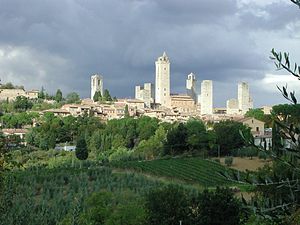

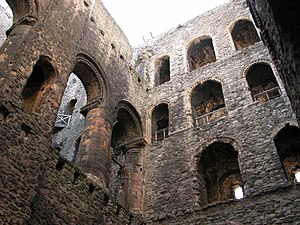


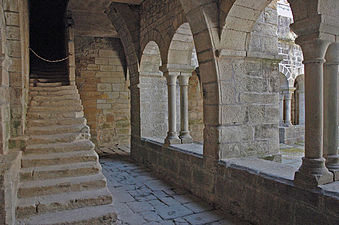




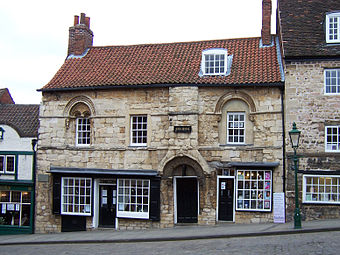



0 Response to "What Does the Communal Construction of Romanesque Art Suggest About Medieval Society"
Post a Comment